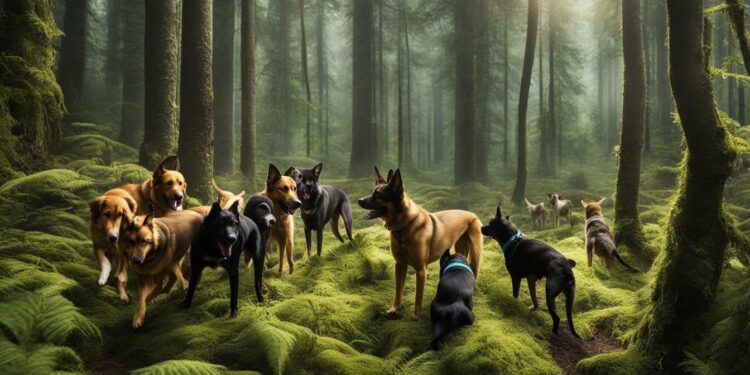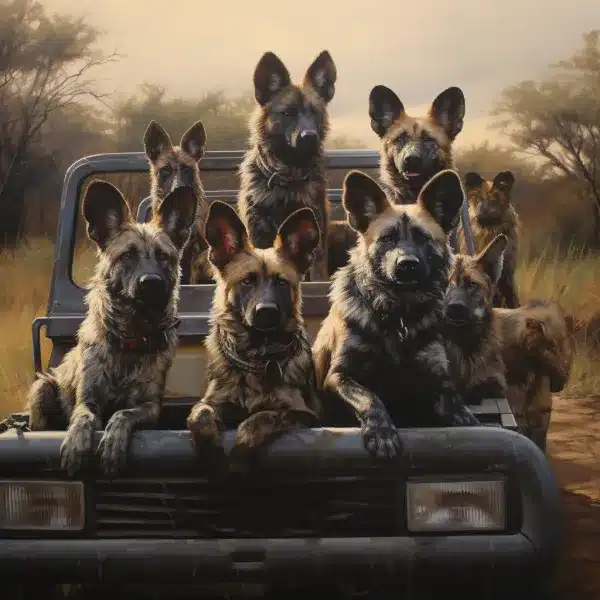Canine Heroes: Dogs In Wildlife Conservation Efforts

Dogs In Wildlife Conservation: Dogs play a crucial role in wildlife conservation efforts by using their powerful sense of smell to locate scat, or feces, of endangered species. By analyzing the scat, scientists can gather important information about the animal’s diet, health, and habitat. Detection dogs are trained to find specific odors and can locate scats much faster than humans. The dogs and their human handlers work as a team, navigating through rough terrain to find hidden scat samples. Many of these detection dogs are adopted from shelters and given a second chance to contribute to conservation efforts. Overall, dogs are an invaluable tool in preserving endangered species and maintaining the balance of ecosystems.
The Importance of Wildlife Conservation
Wildlife conservation is essential for preserving endangered species and ensuring the sustainability of ecosystems. By protecting and restoring habitats, we can maintain the delicate balance of nature and prevent the loss of biodiversity. Through conservation efforts, we strive to safeguard the natural world, its animals, and their habitats for future generations.
Animals are vital to ecosystems. Pollination, seed dissemination, and pest management are essential for environmental health. Many species are endangered by habitat loss, climate change, and illicit wildlife trading. Wildlife conservation can reverse these trends and protect our planet’s unique species.
Conservation tactics include wildlife corridors, protected areas, and sustainable management. These activities benefit endangered species and local economies and societies. Wildlife tourism raises conservation awareness and generates cash and jobs.
The Role of Individuals in Wildlife Conservation
While groups and governments are vital to wildlife protection, everyone can help. Reducing waste, supporting sustainable products, and promoting green activities can make a big difference. Educating ourselves and others about animal conservation promotes responsibility and action.
| Actions for Wildlife Conservation | Impact |
|---|---|
| Supporting conservation organizations | Financial contributions aid in research, protection, and restoration efforts. |
| Volunteering in conservation projects | Hands-on work in the field helps protect habitats and monitor wildlife populations. |
| Advocating for stronger conservation policies | Raising awareness and engaging with lawmakers can lead to better protection for endangered species. |
| Adopting sustainable practices | Reducing our carbon footprint and supporting eco-friendly alternatives contribute to conservation. |
By working together, we can create a future where wildlife thrives and ecosystems flourish. Through our collective efforts, we have the power to protect endangered species and preserve the natural wonders of our world for generations to come.
The Need for Effective Conservation Techniques
To address the threats faced by endangered species, it is crucial to employ effective conservation techniques. In the realm of wildlife conservation, one such technique that has proven to be highly beneficial is the use of dogs. These remarkable animals possess a powerful sense of smell, making them an invaluable tool in locating scat, or feces, of endangered species.
Dogs can find scat samples that are hard to find by identifying certain smells. Their sense of smell is excellent and can cover large areas quickly, making data collection faster. Dogs and their handlers work together to locate scat samples in difficult environments, which provides important information about the animals’ diet, health, and habitat. Many conservation dogs are rescued from shelters, which gives them a new chance to help with important conservation work. By using dogs, conservationists and scientists can collect important information to protect endangered species and ecosystems.
| Benefits of Dogs in Wildlife Conservation |
|---|
| Dogs have a powerful sense of smell, enabling them to locate scat samples of endangered species. |
| They can cover large areas quickly, expediting the data collection process. |
| Dogs and their human handlers work as a team, navigating through challenging terrains to find hidden scat samples. |
| Many detection dogs are adopted from shelters, giving them a second chance to contribute to conservation efforts. |
| The information gathered from scat analysis helps in preserving endangered species and maintaining ecosystems. |
The Power of a Dog’s Sense of Smell
Dogs have an incredible sense of smell, which makes them an invaluable asset in wildlife conservation. Their noses are equipped with an estimated 220 million olfactory receptors, allowing them to detect scents that are undetectable to humans. This remarkable sense of smell enables dogs to locate scat, or feces, of endangered species with astonishing accuracy.
Through their keen sense of smell, dogs can detect scent particles in the air, on the ground, and even underwater. This ability is particularly beneficial in the field of wildlife conservation, where locating scat is crucial for understanding the behavior, diet, and health of endangered animals. By analyzing the scat samples, scientists can gather vital information that aids in the preservation of endangered species and the maintenance of ecosystems.
Dogs in Wildlife Conservation
Detection dogs play a pivotal role in this process. These highly trained canines are able to locate specific odors, such as those emitted by endangered species, with remarkable efficiency. Their training allows them to navigate through challenging terrains, including dense forests and rugged mountains, to find hidden scat samples. Working in tandem with their human handlers, these dogs are an integral part of conservation efforts, providing valuable data that helps scientists make informed decisions about habitat management and species protection.
| Dogs in Wildlife Conservation | Benefits |
|---|---|
| Powerful sense of smell | Enables detection of scat samples |
| Efficiency | Faster than humans at locating scat |
| Collaborative effort | Human handlers work with dogs as a team |
| Second chance | Many detection dogs are adopted from shelters |
The use of dogs in wildlife conservation is not only effective but also has a positive impact on animal welfare. Many of the detection dogs involved in these efforts are adopted from shelters, providing them with a second chance at life while making a significant contribution to conservation. This partnership between humans and dogs exemplifies the potential for collaboration and highlights the importance of utilizing all available resources to preserve endangered species and safeguard ecosystems for future generations.
Using Dogs to Locate Endangered Species’ Scat
Dogs are trained to locate scat samples of endangered species, providing valuable insights into their diet, health, and habitat. Their exceptional sense of smell allows them to detect scat hidden in dense forests or hard-to-reach areas, where humans may struggle to locate it. These specially trained dogs play a crucial role in wildlife conservation efforts, aiding scientists in their quest to protect and preserve endangered species.
Using their powerful sense of smell, detection dogs are able to identify the unique odor signatures of specific species, making them highly effective in locating scat samples. With their keen noses, they can distinguish scat from different species, helping scientists gather vital information about the animal’s diet and health. By analyzing the scat, researchers can gain insights into an endangered species’ habitat and behavior, enabling them to develop targeted conservation plans.
The collaboration between dogs and their human handlers is essential in wildlife conservation work. Together, they navigate through challenging terrains, including dense forests and rugged landscapes, to find hidden scat samples. The highly trained dogs rely on their handlers’ guidance to search systematically, ensuring that no scat goes unnoticed. This partnership between dogs and humans is a testament to the power of teamwork in achieving conservation goals.
| Benefits of using dogs in locating scat: |
|---|
| Dogs have an exceptional sense of smell, making them highly effective in locating scat samples. |
| They can distinguish scat from different species, providing valuable insights into an animal’s diet and health. |
| Detection dogs work in partnership with human handlers to navigate through challenging terrains, ensuring thorough scat searches. |
| Many detection dogs are adopted from shelters, giving them a second chance at contributing to wildlife conservation efforts. |
The Efficiency of Detection Dogs in Scat Location
Compared to human search efforts, detection dogs are significantly faster and more efficient in locating scat samples. While humans may spend hours or even days searching for scat, dogs can cover vast areas in a fraction of the time. Their remarkable sense of smell enables them to pinpoint scat with precision, optimizing the time and resources dedicated to wildlife conservation efforts.
The future looks promising for dogs in wildlife conservation. As technology and training techniques continue to advance, dogs’ capabilities in locating scat and aiding conservation efforts will only improve. With their unwavering dedication and natural abilities, dogs play an indispensable role in preserving endangered species and maintaining the delicate balance of ecosystems.
Analyzing Scat for Conservation Purposes
Analyzing scat samples helps scientists gather important data for wildlife conservation purposes. The study of scat, or feces, provides valuable insights into the diet, health, and habitat of endangered species. By closely examining scat, scientists can determine the animal’s food preferences, detect signs of disease or stress, and even track their movement patterns. This information is crucial for developing effective conservation strategies and ensuring the long-term survival of these vulnerable species.
Through the use of detection dogs, the process of locating and collecting scat samples has become more efficient and accurate. These remarkable canines are trained to identify specific odors associated with various wildlife species. With their keen sense of smell, detection dogs can easily sniff out scat from even the most elusive animals, saving valuable time and resources in conservation efforts.
The partnership between dogs and their human handlers is essential in this work. Together, they navigate through rugged terrains, carefully searching for hidden scat samples. The bond between the dog and handler is based on trust and collaboration, allowing them to work seamlessly as a team. Their concerted efforts contribute to the collection of high-quality scat samples, which serve as a vital source of information for scientists.
| Benefits of Analyzing Scat for Wildlife Conservation: |
|---|
| 1. Comprehensive dietary analysis |
| 2. Identification of potential health issues |
| 3. Assessment of habitat usage and movement patterns |
| 4. Development of targeted conservation strategies |
By utilizing detection dogs to locate and analyze scat samples, scientists gain valuable insights into endangered species’ behaviors and needs. This knowledge helps inform conservation efforts and ultimately contributes to the preservation of our precious wildlife.
The Efficiency of Detection Dogs
Detection dogs are trained to find specific odors and can locate scat samples much faster than humans. Their exceptional sense of smell enables them to detect even the faintest scent trails left by endangered species. With their powerful noses, dogs play a critical role in wildlife conservation efforts, aiding scientists in gathering vital information about these animals.
Working as a team with their human handlers, these highly trained canines navigate through challenging terrains, such as dense forests or rugged mountains, to search for hidden scat samples. Their ability to cover large areas quickly and efficiently makes them an invaluable tool in locating endangered species and studying their behaviors.
Many of these detection dogs have been adopted from shelters, giving them a second chance to contribute to conservation efforts. These rescue dogs, with their incredible olfactory abilities, become guardians of biodiversity, safeguarding endangered species and their habitats. Their dedication and hard work showcase the potential for dogs to make a significant impact in preserving our natural world.
The Importance of Collaboration
Collaboration between organizations and conservation initiatives is key to harnessing the full potential of dogs in wildlife conservation. By working together, researchers, canine handlers, and conservationists can develop effective strategies and techniques to protect endangered species and restore fragile ecosystems.
As technology advances and our understanding of the role dogs play in conservation deepens, the future looks promising for these incredible canines. Their exceptional sense of smell, combined with their loyalty and dedication, positions dogs as a powerful tool in ensuring the survival of endangered species and the preservation of our natural world.
| Benefits of Detection Dogs in Wildlife Conservation |
|---|
| Efficient and fast detection of scat samples |
| Ability to cover large areas quickly |
| Aid in gathering vital information about endangered species |
| Adopted from shelters, giving them a second chance |
| Preservation of biodiversity and ecosystems |
Overall, dogs have proven to be invaluable partners in wildlife conservation. Their unique skills and unwavering dedication make them an essential asset in the ongoing efforts to protect and preserve endangered species and their habitats.
Dogs and Human Handlers as a Team
Dogs and their human handlers work as a team, navigating through rough terrain to find hidden scat samples. These dedicated partnerships are a crucial component of wildlife conservation efforts. With their keen sense of smell, dogs can detect scat from a variety of endangered species, including elusive predators and rare mammals.
Trained detection dogs are able to locate scat much faster than humans, making them invaluable in the field. They are able to distinguish specific odors and track down scat samples that might otherwise go unnoticed. Their proficiency in finding scat provides scientists with vital information about the animals’ diet, health, and habitat.
Many of these remarkable detection dogs are rescued from shelters, giving them a second chance at life and a meaningful role in conservation efforts. Adopted and trained, these dogs become highly skilled at locating scat and play a significant part in preserving endangered species and maintaining the delicate balance of ecosystems.
Working Together for Conservation Success
The collaboration between dogs and their human handlers is essential for maximizing the efficiency of scat detection. The handlers guide the dogs through challenging terrain, utilizing their deep knowledge of animal behavior and habitat preferences. Together, they form a cohesive unit, working tirelessly to find hidden scat samples that hold a wealth of information for researchers and conservationists.
| Dogs in Wildlife Conservation | |
|---|---|
| Breed | Labrador Retriever |
| Training | Specialized scent training programs |
| Skills | Locating scat, tracking specific odors |
| Impact | Preserving endangered species, maintaining ecosystems |
Successful teams in wildlife conservation depend on the strong bond between dogs and their human handlers. They build trust through training and fieldwork. Handlers use the dogs’ sense of smell, while the dogs rely on their handlers’ guidance. These teams work together to locate scat samples of endangered species, which provides important information for conservation efforts. Their partnership contributes to the preservation of endangered species and the health of our ecosystems.
Rescue Dogs Making a Difference
Rescue dogs help wildlife conservation, giving them a purpose. These rescue pups are trained to find extinct species’ feces. These dogs help animals while finding themselves.
The training of detecting dogs is demanding and needs a close handler-dog bond. They search difficult terrain for hidden scat samples together. Scientists may learn about endangered species’ nutrition, health, and habitat by using the canines’ keen sense of smell to identify their scents. These contributions are vital to understanding and safeguarding endangered species.
Rescue dogs help wildlife and grow personally. They get a new life and use their skills to help the environment. They learned essential talents after being neglected. Because of this, all shelter dogs should be adopted.
| Benefits of Rescue Dogs in Wildlife Conservation: |
|---|
| 1. Meaningful purpose and a chance to make a difference. |
| 2. Specialized training to become detection dogs. |
| 3. Contributing to the protection of endangered species. |
| 4. Finding their own place in the world. |
Rescue dogs are important for wildlife conservation. They give animals a home and help with research. These dogs are heroes because they help endangered species and make the world better for all animals.
Dogs in Wildlife Conservation: Success Stories
Dogs help preserve endangered species by using their sense of smell to find scat. Scientists study the scat to understand the animals’ diet, health, and habitat. This information is used to protect and conserve the species. For example, Luna found the scat of a rare wild cat, which led to conservation efforts. Rescue dogs also helped monitor endangered marine mammals. The way these marine animals reproduce, what they eat, and how healthy they are overall.
| Success Story | Species | Impact |
|---|---|---|
| Luna’s Discovery | Rare wild cat | Confirmation of species presence, establishment of protected areas |
| Rescue Dogs on the Coast | Endangered marine mammals | Data collection for population monitoring and conservation efforts |
These are just two examples of how dogs have made a significant difference in wildlife conservation. Their exceptional sense of smell and tireless dedication make them valuable allies in the ongoing battle to protect endangered species and maintain the delicate balance of ecosystems. With continued support and investment, dogs will continue to play a critical role in preserving our planet’s biodiversity for future generations.
Preserving Endangered Species
Dogs help conserve biodiversity by saving endangered species. Their keen sense of smell helps scientists find endangered animal scat samples, revealing their nutrition, health, and habitat. Researchers can better understand these species’ needs and execute effective conservation efforts by examining the scat. Dogs trained to detect target species’ odors are good scat sample finders. Dogs save resources and help environmentalists collect data by traveling vast distances faster than people. Speed and accuracy aid endangered species conservation.
Wildlife conservation dogs and handlers work well together. They search difficult terrain for hidden scat samples. Strong human-dog bonds provide good communication and collaboration, enabling essential data collecting. These activities use many shelter-adopted detection dogs, giving them a second chance and supporting conservation efforts.
The Role of Dogs in Ecosystem Preservation
Ecosystem balance and biodiversity depend on endangered species. Dogs defend these ecosystems, protecting endangered animals and their habitats. Dogs protect habitats and the animals that depend on them by avoiding their decline.
| Benefits of Dogs in Wildlife Conservation | Benefits of Dogs in Ecosystem Preservation |
|---|---|
|
|
“Dogs play a crucial role in preserving endangered species, contributing to the overall conservation of biodiversity.”
The future of dogs in wildlife conservation is promising, with ongoing advancements in training and technology. As new tools and techniques emerge, dogs will continue to be vital partners in conservation initiatives. Their unique abilities and unwavering dedication make them an invaluable asset in the ongoing effort to protect and preserve endangered species and the ecosystems they inhabit.
Dogs as Guardians of Ecosystems
Dogs help protect endangered species and their habitats. They use their sense of smell to find scat, which scientists use to gather important information about the animals’ diet, health, and habitat. Detection dogs are trained to find specific odors and are better at finding scat than humans. They work with human handlers to cover vast areas and assist in conservation efforts. Many of these dogs are adopted from shelters and trained to help protect wildlife, showing that everyone, including pets, can make a difference in conservation.
| The Role of Dogs in Wildlife Conservation | |
|---|---|
| Significance | Dogs are a powerful tool in wildlife conservation efforts, aiding in the preservation of endangered species and maintaining the balance of ecosystems. |
| Training | Detection dogs are trained to locate scat samples of endangered species, utilizing their exceptional sense of smell to gather important data. |
| Saving Lives | Many detection dogs used in wildlife conservation have been adopted from shelters, providing them with a second chance to contribute to conservation efforts. |
Dogs protect endangered creatures and their habitats, maintaining biodiversity. Their unparalleled sense of smell and unwavering dedication make them an invaluable asset in wildlife conservation efforts. By utilizing their unique abilities, dogs are helping to preserve biodiversity and maintain the delicate balance of our natural world.
Dogs and Wildlife Conservation Partnerships
Dogs help safeguard wildlife through group interactions and conservation activities. These teams employ canines’ keen sense of smell to find endangered species’ scat samples. Finding and researching animal feces samples can teach scientists about their food, health, and surroundings.
Detection dogs and their handlers must navigate tough terrain to find buried scat samples. Dogs can detect smells faster than humans due to their keen sense of smell. Due to their speed and utility, they aid protective efforts.
It’s noteworthy that many wildlife protection dogs are shelter dogs. Rescue groups train these dogs to preserve wildlife. This is beneficial for animals and illustrates that conservation and animal care groups can collaborate.
The Impact of Dogs in Wildlife Conservation
- Dogs possess powerful sense of smell, allowing for the detection of scat samples.
- Analysis of scat provides vital information about diet, health, and habitat.
- Detection dogs find scat faster than humans, enhancing conservation efforts.
- Partnerships between organizations and shelters provide dogs with a second chance and contribute to conservation goals.
Dogs and wildlife conservation work well together. They help protect endangered animals and keep ecosystems balanced. Organizations partner with dogs to collect data, protect biodiversity, and give shelter dogs a purpose. We need to keep supporting and using dogs in wildlife conservation to protect our planet’s wildlife.
The Future of Dogs in Wildlife Conservation
Dogs are helping wildlife conservation, and more can be done. They have found endangered animal scat samples, which helps conservation. As technology advances, their detection skills will improve. Dogs can learn to recognize animal sickness scents. Scientists could act early and protect vulnerable people. Dogs could prevent invading species from colonizing new regions and harming native fauna.
Conservation can benefit from dog-handler partnerships. Better communication and coordination can boost results. Improved training and bonding help them find more scat samples and data. Other ways dogs might help include finding and tracking wildlife. They can navigate difficult terrain and find rare species.
| Potential Advancements in Dogs’ Role in Wildlife Conservation |
|---|
| Detection of specific diseases affecting wildlife |
| Training dogs to detect invasive species |
| Improved communication and coordination between dogs and handlers |
| Expanded applications beyond scat detection, such as wildlife tracking |
Lastly, dogs have proven effective in wildlife protection. Education, interspecies communication, disease detection, and species monitoring can improve. We can use dogs’ keen sense of smell and agility to protect endangered animals and ecosystems.
The Ongoing Need for Dogs in Conservation
Dogs are important for wildlife conservation and need regular support. They help find scat of endangered species using their sense of smell. They are faster than humans in detecting scat and can collect valuable data to preserve endangered species. Many of these dogs are adopted from shelters. Dogs help maintain balance in ecosystems and protect habitats. They work with organizations to strengthen their impact.
The Future of Dogs in Wildlife Conservation
Future breakthroughs in wildlife conservation using dogs seem promising. Continuous research and innovation can improve dog training and harness their particular qualities. As technology progresses, dogs may be used alongside drones or remote sensing equipment to aid conservation.
It is crucial to understand that wildlife conservation dogs need continuing attention and resources. These crucial conservation partners need adequate money, training, and veterinary care to thrive and function. We can use dogs’ great sense of smell and steadfast determination to conserve our species by investing in their care and training.
| Key Points |
|---|
| Dogs are a valuable tool in wildlife conservation efforts. |
| They use their powerful sense of smell to locate scat samples of endangered species. |
| Detection dogs are trained to find scat much faster than humans. |
| The partnership between dogs and their human handlers is crucial in the field. |
| Consistent support and resources are necessary to sustain the ongoing need for dogs in wildlife conservation. |
Conclusion
Dogs help with wildlife conservation by finding scat from endangered animals. Scientists study the scat to learn about the animals’ diet, health, and habitat. Detection dogs are trained to find scat faster than humans, even in difficult terrain. Dogs and humans work together to protect endangered species.
Conservation efforts are impressive because many detection dogs come from shelters. These dogs have a new purpose in protecting endangered species. They help preserve biodiversity and protect ecosystems. The role of dogs in wildlife conservation will grow with new training techniques and technology. Collaboration between organizations will keep dogs as a vital part of preserving vulnerable species.
FAQ
Q: How do dogs contribute to wildlife conservation efforts?
A: Dogs play a crucial role in wildlife conservation efforts by using their powerful sense of smell to locate scat, or feces, of endangered species. By analyzing the scat, scientists can gather important information about the animals’ diet, health, and habitat.
Q: How are dogs trained to locate scat samples?
A: Since they’re taught to distinguish specific odors, detection dogs can smell feces faster than people. They learn to detect and signal the scents using positive reinforcement.
Q: Why is locating scat important for conservation?
A: Locating scat samples is important for conservation because it provides valuable insights into the animals’ behavior, population size, and overall health. This information helps scientists make informed decisions to protect and manage endangered species and their habitats.
Q: Which dog breeds frequently preserve endangered species?
A: Wildlife protection dogs include Labrador Retrievers, German Shepherds, Border Collies, and Belgian Malinois. These smart, trainable dogs are good at smell.
Q: Use rescue detection dogs?
A: Wildlife protection dogs often come from animal shelters. Giving these dogs a second chance helps conservation efforts while giving them a purpose.
Q: How do dogs and their handlers work together in conservation efforts?
A: Dogs and their human handlers work as a team in conservation efforts. Handlers are trained to read the dog’s behavior and responses, enabling them to navigate difficult terrain and effectively locate scat samples. Their partnership is essential for successful wildlife conservation work.
Q: How fast can detection dogs locate scat samples?
A: Detection dogs can locate scat samples much faster than humans. Their powerful sense of smell allows them to cover large areas efficiently and pinpoint scat with speed and accuracy.
Q: How do dogs aid in preserving endangered species?
A: Dogs aid in preserving endangered species by helping scientists gather crucial data through scat analysis. This information is used to develop conservation strategies, protect habitats, and make informed decisions for the well-being of endangered species.
Q: Dogs do other conservation work?
Canines provide various conservation functions, so absolutely. They can track invasive species, detect animal trafficking, and aid ecosystem restoration.
Q: What are some success stories of dogs in wildlife conservation?
A: There are numerous success stories of dogs in wildlife conservation. For example, conservation dogs have successfully located critically endangered species, contributed to scientific research, and helped prevent the extinction of certain populations.






